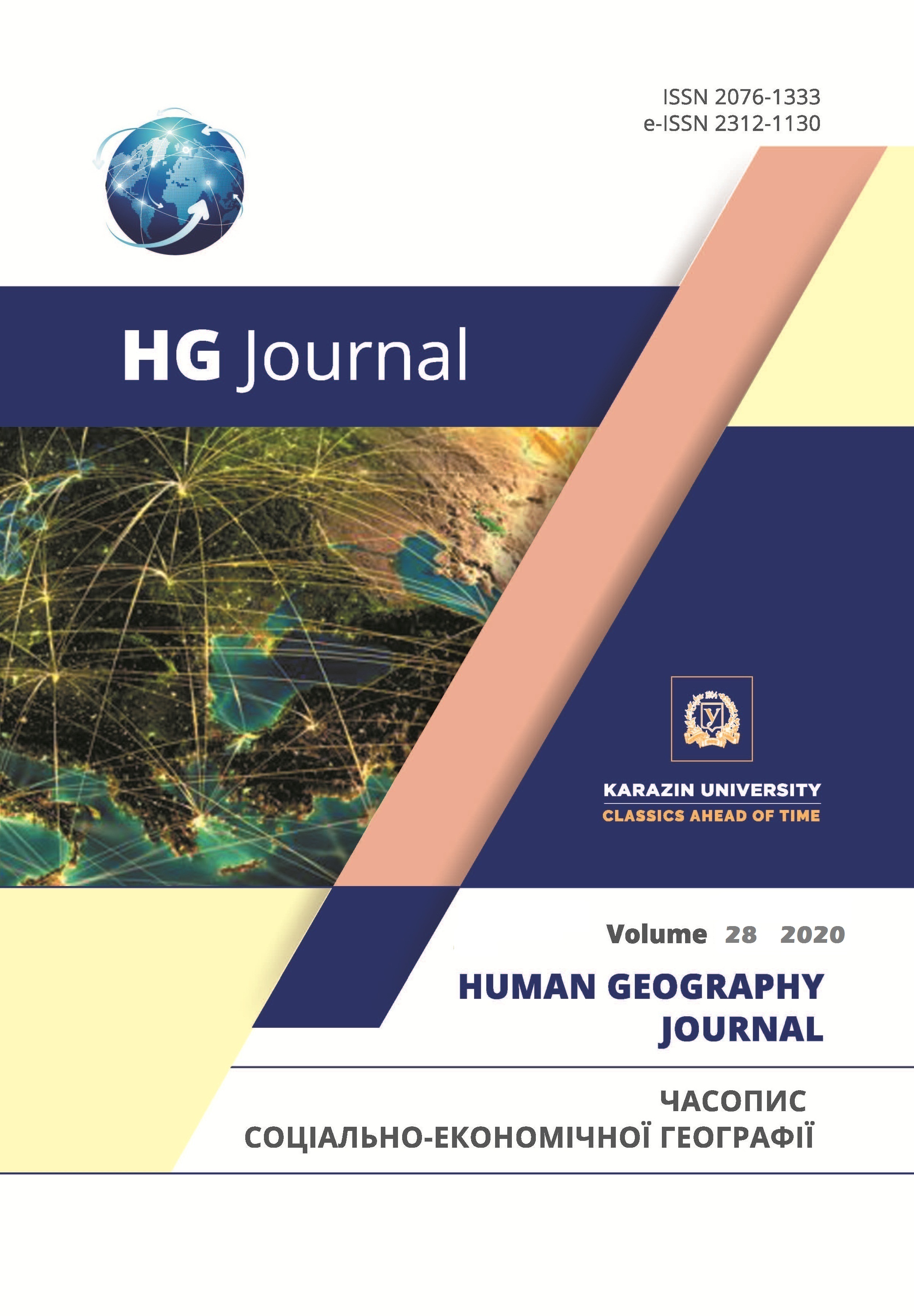Religious component of ethnocultural development of polyetnic region of Chernivtsi oblast
Abstract
In this article the author considers territorial differences in the formation of the religious component of ethnocultural development of Chernivtsi oblast, which is distinguished by its ethnical contact, polyethnicity and transboundariness. Its territory is home to more than 130 ethnic groups, and Ukrainians, Romanians and Moldovans border on densely populated areas. Also unique is the fact that there are two historical and geographical regions of Ukrainians – Northern Bukovina and Northern Bessarabia, as well as parts of the Romanian historical and geographical region – Dorogoy region. In the territory of Northern Bukovina, namely in its mountainous parts, the population belongs to the ethnographic group – Hutsuls, who formed and preserved their ethnic culture.
The years of Ukraine’s independence have been marked by complex transformational processes that happened in many spheres of society: changes in state institutions, political system, property issues, ethnocultural development of the regions, and so on. The moral principles and priorities of both society as a whole and the individual began to differ significantly from the values of the previous generation. There have been radical changes in the religious sphere, as an integral part of the life of any society, one of the important social institutions of the Ukrainian people. The functions and social significance of religion have changed to some extent. Thus, S. Zdioruk defines the social significance of religion "not only by its spiritual or metacultural influence, but also by active political, social and economic activities both in the process of ethnogenesis and the creation and development of the state." This usually indicates the importance of taking into account the religious factor in the formation of regional development, including ethnocultural, which is the basis for the development of tourism, arts, culture and other sectors of the economy.
The article deepens the theoretical and methodological principles of socio-geographical study of ethnocultural development, analyzes the religious component, traces the influence of territory formation and other historical factors on the formation of religious space, its material and spiritual component.
Downloads
References
Zakon Ukrainy Pro zasady derzhavnoi regionalnoi polityky: pryinyatyi 05 lyut. 2015 roku № 156-VIII [Law of Ukraine on the Principles of State Regional Policy from February 5 2015, № 156-VIII]. (2015, Mart 4). Holos Ukrainy – Voice of Ukraine, 39 [in Ukrainian].
Zakon Ukrainy Pro turyzm: pryinyatyi 15 ver. 1995 roku № 324/95-VR [Law of Ukraine on Tourism from September 15 1995, № 324/95-BP]. (1995, November 14). Holos Ukrainy – Voice of Ukraine [in Ukrainian].
Ataman, L.V. (2015). Issledovanie sakralnogo prostranstva regiona: metodologiya i printsypy [Study of sacred space in the region: methodology and principles]. Pskovskiy regionologicheskiy zhurnal – Pskov Regional Journal, 23, 107-117 [in Russian].
Kostyshyn, S.S. (Eds.). (1998). Bukovyna: istorychnyi narys [Bukovyna: a historical essay]. Chernivtsi: Zelena Bukovyna, 416 [in Ukrainian].
Buchko, Zh.I. (2015). Transkordonnyi turyzm u konteksti evrointegratsii Ukrainy [Cross-border tourism is in the context of eurointegration of Ukraine]. Naukovyi visnyk Chernivetszkoho universytetu: Seriya Geografiya – Scientific Bulletin of Chernivtsi University: Series Geography, 744-745, 109-111 [in Ukrainian].
Dzhaman, V., Zablotovska, N., Kostashchuk, I., Staryk, V., & Khalavka, T. (2011). Etnichna mapa bukovynskoho prykordonnya na zlami tysyacholit`[Ethnic map of the Bukovynian frontier at the turn of the millennium]. Chernivtsi: Prut, 64 [in Ukrainian].
Dzhaman, V.O. (2006). Chernivetska oblast – polietnichna etnokontaktna terytoriya [Chernivtsi region is a polyethnic ethnocontact territory]. Naukovyi visnyk Chernivetszkoho universytetu: Seriya Geografiya – Scientific Bulletin of Chernivtsi University: Series Geography, 246, 114-126 [in Ukrainian].
Dzhaman, V.O., & Kostashchuk, I.I. (2009). Natsionalna struktura naselennya etnokontaktnykh zon [National structure of the population of ethnocontact zones]. Chernivtsi: ChNU, 288 [in Ukrainian].
Dzhaman, V.O., Kostashhuk, I.I., & Hrytsevych, V.S. (2019). Religiyni rumunomovni hromady Chernivetszkoi oblasti [Religious Romanian-speaking communities of Chernivtsi region]. Bintel. Zhurnal geopolitychnoi analityky – Bintel. Journal of Geopolitical Analytics, 1, 21-29 [in Ukrainian], 65-70 [in English].
Dnistryanskyi, M.S. (2014). Politychna geografiya Ukrainy: navchalnyi posibnyk [Political geography of Ukraine: a textbook]. Lviv: LNU im. Ivana Franka, 348 [in Ukrainian].
Kostashchuk, I.I. (2004). Osoblyvosti proyavu religiynoi prynalezhnosti naselennya u yogo natsionalniy strukturi (na prykladi Chernivetszkoi oblasti) [Features of the manifestation of religious affiliation of the population in its national structure (on the example of Chernivtsi region)]. Naukovi zapysky Ternopilskoho natsionalnoho pedagogichnoho universytetu. Seriya: Geografiya – Scientific notes of Ternopil National Pedagogical University. Series: Geography, 3, 119-122 [in Ukrainian].
Kostashchuk, I.I. (2011). Terytorialna organizatsiya religiynoi sfery regioniv Ukrainy [Territorial organization of the religious sphere of the regions of Ukraine]. Uchenye zapiski Tavricheskoho natsionalnogo universiteta im. V.I. Vernadskogo. Nauchnyi zhurnal. Seriya «Geografiya» - Scientific notes of V.I. Vernadsky Tauride National University. Scientific journal. Geography series, Tom 24 (63), № 2, Chast 3, 137-143 [in Ukrainian].
Kostashhuk, I.I. (2005). Terytorialni osoblyvosti natsionalnoho skladu naselennya Chernivetszkoi oblasti [Territorial features of the national composition of the population of Chernivtsi region]. Naukovi zapysky Vinnytskoho derzhavnoho pedagogichnoho universytetu imeni Mykhaila Kotsyubynskoho. Seriya : Geografiya – Scientific notes of Vinnytsia State Pedagogical University named after Mykhailo Kotsyubynsky. Series: Geography, 8, 131-133 [in Ukrainian].
Krul, V.P. (1999). Krayeznavstvo: istorychna geografiya [Local lore: historical geography]. Chernivtsi: Chernivetskyi derzh. un-t im. Yu. Fedkovycha, 107 [in Ukrainian].
Ekkel, B.M. (1976). Opredelenie indeksa mozaichnosti natsionalnogo sostava respublk, kraev i oblastey SSSR [Determination of the mosaic index of the national composition of the republics, territories and regions of the USSR]. Sovetskaya etnografiya, 2, 33-42 [in Russian].
Materialy saytu Derzhavnoi sluzhby statystyky Ukrainy [Materials of the site of the State Statistics Service of Ukraine]. www.ukrstat.gov.ua. Retrieved from http://www.ukrstat.gov.ua.
Kontent-materialy saytu Religiyno-informatsiynoi sluzhby Ukrainy [Content materials of the site of the Religious Information Service of Ukraine]. risu.org.ua. Retrieved from https://risu.org.ua.
Materialy ofitsiynoi storinky perepysu naselennya Ukrainy – 2001 [Materials of the official page of the census of the population of Ukraine – 2001]. 2001.ukrcensus.gov.ua. Retrieved from http://2001.ukrcensus.gov.ua.
Materialy saytu Holovnoho upravlinnya statystyky u Chernivetskiy oblasti [Materials of the site of the Main Department of Statistics in Chernivtsi region]. www.cv.ukrstat.gov.ua. Retrieved from http://www.cv.ukrstat.gov.ua.
Copyright (c) 2020 © Kostashchuk I.

This work is licensed under a Creative Commons Attribution 4.0 International License.




